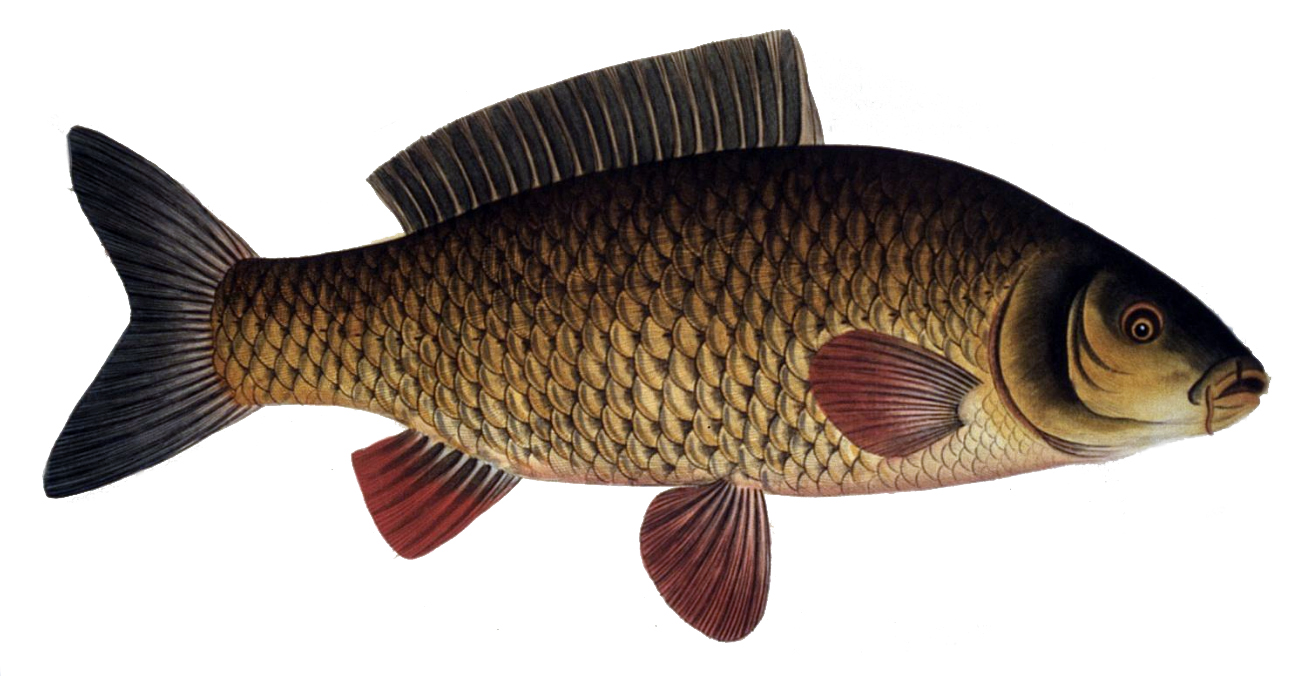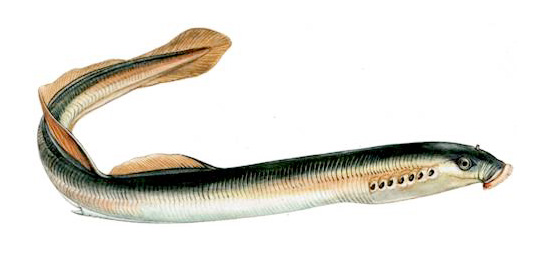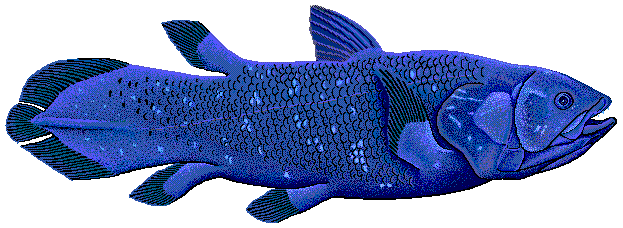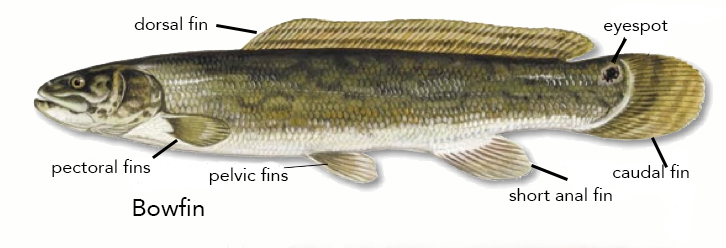|
Parasemionotiformes
Parasemionotiformes is an extinct order of neopterygian ray-finned fish that existed globally during the Triassic period. It comprises the families Parasemionotidae and Promecosominidae. Many of the included genera are monotypic and most species lived during the Early Triassic epoch. Parasemionotiforms were normally small to medium-sized fishes. They were predominantly marine. Evolutionary relationships Parasemionotiformes are neopterygians, which is the clade that encompasses the vast majority of living ray-finned fishes (Actinopterygii) and about half of all living species of vertebrates. Neopterygii are divided into Teleostei and Holostei. The latter represents a depauperate group today but used to be a diverse clade especially during the Mesozoic Era. The only surviving members of the Holostei are the gars ( Ginglymodi) and the bowfin (Halecomorphi). Parasemionotiformes belong to Holostei and are one of the earliest clades of the Halecomorphi (bowfin and its extinct rela ... [...More Info...] [...Related Items...] OR: [Wikipedia] [Google] [Baidu] |
Halecomorphi
Halecomorphi is a taxon of Actinopterygii, ray-finned bony fish in the clade Neopterygii. The only extant Halecomorph species are the bowfin (''Amia calva'') and eyespot bowfin (''Amia ocellicauda''), but the group contains many extinct species in several family (biology), families (including Amiidae, Caturidae, Liodesmidae, Sinamiidae) in the order (biology), order Amiiformes, as well as the extinct orders Ionoscopiformes, Panxianichthyiformes, and Parasemionotiformes. The fossil record of halecomorphs goes back at least to the Early Triassic epoch (geology), epoch. The Halecomorphi exhibit a combination of plesiomorphy, ancestral features, such as most heavily mineralized fish scale, scales, but also by more derived or "modern" features, particularly in the structure of the skull (e.g. position and shape of preopercles). Unique derived traits (synapomorphies) of the Halecomorphi include: *Unique jaw articulation in which the Quadrate bone, quadrate and Symplectic bone, sy ... [...More Info...] [...Related Items...] OR: [Wikipedia] [Google] [Baidu] |
Neopterygian
Neopterygii (from Greek νέος ''neos'' 'new' and πτέρυξ ''pteryx'' 'fin') is a subclass of ray-finned fish (Actinopterygii). Neopterygii includes the Holostei and the Teleostei, of which the latter comprise the vast majority of extant fishes, and over half of all living vertebrate species. While living holosteans include only freshwater taxa, teleosts are diverse in both freshwater and marine environments. Many new species of teleosts are scientifically described each year. The potentially oldest known neopterygian is the putative " semionotiform" '' Acentrophorus varians'' from the Middle Permian of Russia; however, one study incorporating morphological data from fossils and molecular data from nuclear and mitochondrial DNA, places this divergence date at least 284 mya (million years ago), during the Artinskian stage of the Early Permian. Another study suggests an even earlier split (360 myr ago, near the Devonian-Carboniferous boundary). Evolution and d ... [...More Info...] [...Related Items...] OR: [Wikipedia] [Google] [Baidu] |
Neopterygii
Neopterygii (from Greek νέος ''neos'' 'new' and πτέρυξ ''pteryx'' 'fin') is a subclass of ray-finned fish (Actinopterygii). Neopterygii includes the Holostei and the Teleostei, of which the latter comprise the vast majority of extant fishes, and over half of all living vertebrate species. While living holosteans include only freshwater taxa, teleosts are diverse in both freshwater and marine environments. Many new species of teleosts are scientifically described each year. The potentially oldest known neopterygian is the putative " semionotiform" '' Acentrophorus varians'' from the Middle Permian of Russia; however, one study incorporating morphological data from fossils and molecular data from nuclear and mitochondrial DNA, places this divergence date at least 284 mya (million years ago), during the Artinskian stage of the Early Permian. Another study suggests an even earlier split (360 myr ago, near the Devonian-Carboniferous boundary). Evolution a ... [...More Info...] [...Related Items...] OR: [Wikipedia] [Google] [Baidu] |
Ray-finned Fish
Actinopterygii (; ), members of which are known as ray-finned fish or actinopterygians, is a class of bony fish that comprise over 50% of living vertebrate species. They are so called because of their lightly built fins made of webbings of skin supported by radially extended thin bony spines called '' lepidotrichia'', as opposed to the bulkier, fleshy lobed fins of the sister clade Sarcopterygii (lobe-finned fish). Resembling folding fans, the actinopterygian fins can easily change shape and wetted area, providing superior thrust-to-weight ratios per movement compared to sarcopterygian and chondrichthyian fins. The fin rays attach directly to the proximal or basal skeletal elements, the radials, which represent the articulation between these fins and the internal skeleton (e.g., pelvic and pectoral girdles). The vast majority of actinopterygians are teleosts. By species count, they dominate the subphylum Vertebrata, and constitute nearly 99% of the over 30,000 extant ... [...More Info...] [...Related Items...] OR: [Wikipedia] [Google] [Baidu] |
Vertebrates
Vertebrates () are animals with a vertebral column (backbone or spine), and a cranium, or skull. The vertebral column surrounds and protects the spinal cord, while the cranium protects the brain. The vertebrates make up the subphylum Vertebrata with some 65,000 species, by far the largest ranked grouping in the phylum Chordata. The vertebrates include mammals, birds, amphibians, and various classes of fish and reptiles. The fish include the jawless Agnatha, and the jawed Gnathostomata. The jawed fish include both the Chondrichthyes, cartilaginous fish and the Osteichthyes, bony fish. Bony fish include the Sarcopterygii, lobe-finned fish, which gave rise to the tetrapods, the animals with four limbs. Despite their success, vertebrates still only make up less than five percent of all described animal species. The first vertebrates appeared in the Cambrian explosion some 518 million years ago. Jawed vertebrates evolved in the Ordovician, followed by bony fishes in the Devonian. T ... [...More Info...] [...Related Items...] OR: [Wikipedia] [Google] [Baidu] |
Mesozoic
The Mesozoic Era is the Era (geology), era of Earth's Geologic time scale, geological history, lasting from about , comprising the Triassic, Jurassic and Cretaceous Period (geology), Periods. It is characterized by the dominance of archosaurian reptiles such as the dinosaurs, and of Gymnosperm, gymnosperms such as cycads, ginkgoaceae and Araucariaceae, araucarian conifers; a hot Greenhouse and icehouse earth, greenhouse climate; and the tectonic break-up of Pangaea. The Mesozoic is the middle of the three eras since Cambrian explosion, complex life evolved: the Paleozoic, the Mesozoic, and the Cenozoic. The era began in the wake of the Permian–Triassic extinction event, the largest mass extinction in Earth's history, and ended with the Cretaceous–Paleogene extinction event, another mass extinction whose victims included the non-avian dinosaurs, Pterosaur, pterosaurs, Mosasaur, mosasaurs, and Plesiosaur, plesiosaurs. The Mesozoic was a time of significant tectonic, climatic, an ... [...More Info...] [...Related Items...] OR: [Wikipedia] [Google] [Baidu] |
Era (geology)
The geologic time scale or geological time scale (GTS) is a representation of time based on the rock record of Earth. It is a system of chronological dating that uses chronostratigraphy (the process of relating strata to time) and geochronology (a scientific branch of geology that aims to determine the age of rocks). It is used primarily by Earth scientists (including geologists, paleontologists, geophysicists, geochemists, and paleoclimatologists) to describe the timing and relationships of events in geologic history. The time scale has been developed through the study of rock layers and the observation of their relationships and identifying features such as lithologies, paleomagnetic properties, and fossils. The definition of standardised international units of geological time is the responsibility of the International Commission on Stratigraphy (ICS), a constituent body of the International Union of Geological Sciences (IUGS), whose primary objective is to precisely de ... [...More Info...] [...Related Items...] OR: [Wikipedia] [Google] [Baidu] |
Ginglymodi
Ginglymodi is a clade of ray-finned fish containing modern-day gars (Lepisosteidae) and their extinct relatives (including the family (biology), family Lepidotidae) in the Order (biology), order Lepisosteiformes, the extinct orders Semionotiformes and Kyphosichthyiformes, and various other extinct taxa. Ginglymodi is one of the two major subgroups of the infraclass Holostei, the other one being Halecomorphi, which contains the bowfin and eyespot bowfin and their fossil relatives. Fossil record The fossil record of ginglymodians goes back at least to the Anisian stage (geology), stage of the Triassic period (geology), period, over 240 million years ago. ''Eosemionotus'' is one of the earliest ginglymodians. ''Acentrophorus'', another taxon from the Middle and Late Permian, and ''Paracentrophorus'' from the Early Triassic epoch (geology), epoch, could be even earlier members of the group. Ginglymodi was biodiversity, diverse and widespread during the Mesozoic era (geology), era, bu ... [...More Info...] [...Related Items...] OR: [Wikipedia] [Google] [Baidu] |
Bowfin
The ruddy bowfin (''Amia calva'') is a ray-finned fish native to North America. Common names include mudfish, mud pike, dogfish, grindle, grinnel, swamp trout, and choupique. It is regarded as a relict, being one of only two surviving species of the Halecomorphi, a group of fish that first appeared during the Early Triassic, around 250 million years ago. The bowfin is often considered a "living fossil" because they have retained some morphological characteristics of their early ancestors. It is one of two species in the genus ''Amia,'' along with '' Amia ocellicauda'', the eyespot bowfin. The closest living relatives of bowfins are gars, with the two groups being united in the clade Holostei. Bowfins are demersal freshwater piscivores, commonly found throughout much of the eastern United States, and in southern Ontario and Quebec. Fossil deposits indicate Amiiformes were once widespread in both freshwater and marine environments across North and South America, Europe, ... [...More Info...] [...Related Items...] OR: [Wikipedia] [Google] [Baidu] |
Induan
The Induan is the first age of the Early Triassic epoch in the geologic timescale, or the lowest stage of the Lower Triassic series in chronostratigraphy. It spans the time between 251.9 Ma and 249.9 Ma (million years ago). The Induan is sometimes divided into the Griesbachian and the Dienerian subages or substages. The Induan is preceded by the Changhsingian (latest Permian) and is followed by the Olenekian. The Induan is roughly coeval with the regional Feixianguanian Stage of China. Geology Stratigraphy The Triassic is the first period of the Mesozoic era. It is subdivided into the Lower, Middle, and Upper Triassic series, which are further subdivided into stages. The Induan is the first stage of the Lower Triassic, from 251.9 million to 249.9 million years ago, spanning the first 2 million years after the Permian–Triassic extinction event. Stages can be defined globally or regionally. For global stratigraphic correlation, the International Commission on Str ... [...More Info...] [...Related Items...] OR: [Wikipedia] [Google] [Baidu] |
Ocean
The ocean is the body of salt water that covers approximately 70.8% of Earth. The ocean is conventionally divided into large bodies of water, which are also referred to as ''oceans'' (the Pacific, Atlantic, Indian Ocean, Indian, Southern Ocean, Antarctic/Southern, and Arctic Ocean),"Ocean." ''Merriam-Webster.com Dictionary'', Merriam-Webster, https://www.merriam-webster.com/dictionary/ocean . Accessed March 14, 2021. and are themselves mostly divided into seas, gulfs and Lists of bodies of water#Seawater bodies, subsequent bodies of water. The ocean contains 97% of Water distribution on Earth, Earth's water and is the primary component of Earth's hydrosphere, acting as a huge Ocean heat content, reservoir of heat for Earth's energy budget, as well as for its carbon cycle and water cycl ... [...More Info...] [...Related Items...] OR: [Wikipedia] [Google] [Baidu] |








